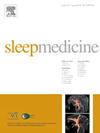Quality of life and its associates in narcolepsy 1 and 2 types and idiopathic hypersomnia
IF 3.8
2区 医学
Q1 CLINICAL NEUROLOGY
引用次数: 0
Abstract
Objective and background
Health-related quality of life (HRQoL) is reduced in narcolepsy type 1 (NT1), but proper information on HRQoL in narcolepsy type 2 (NT2) and idiopathic hypersomnia (IH) is lacking. This study examines HRQoL of NT1, NT2, IH, and healthy controls (HC) and assesses the HRQoL associates in these diseases.
Patients and methods
117 adults (64 NT1, 22 NT2, 31 IH; 61.5 % women; 38.3 ± 12.0 years; 71.8 % treated) and 41 HC (53.7 % women; 35.9 ± 9.6 years) completed questionnaires assessing sleepiness, fatigue, symptoms severity, sleep inertia, depressive and anxiety symptoms, HRQoL, and underwent a semi-structured interview. Data were analyzed using the Mann-Whitney and Kruskal-Wallis tests, Spearman's correlation coefficient, and regression analysis.
Results
HRQoL of NT1, NT2, and IH, separately, was poorer compared to HC (p < 0.001). According to the 36-Item Short Form Health Survey, the mental HRQoL was more impaired in NT2 and IH than NT1 (p < 0.05) in association with more pronounced depressive symptoms (p < 0.01; p < 0.05, respectively) and sleep inertia (p < 0.01; p < 0.01, respectively). Psychiatric disorders were more prevalent in NT2 and IH versus NT1 (p < 0.05).
Conclusion
HRQoL is reduced in NT1, NT2, and IH, with this reduction being more pronounced in NT2 and IH. Poor mental HRQoL of NT2 and IH was associated both with the severity of depressive symptoms and more intense sleep inertia.
求助全文
约1分钟内获得全文
求助全文
来源期刊

Sleep medicine
医学-临床神经学
CiteScore
8.40
自引率
6.20%
发文量
1060
审稿时长
49 days
期刊介绍:
Sleep Medicine aims to be a journal no one involved in clinical sleep medicine can do without.
A journal primarily focussing on the human aspects of sleep, integrating the various disciplines that are involved in sleep medicine: neurology, clinical neurophysiology, internal medicine (particularly pulmonology and cardiology), psychology, psychiatry, sleep technology, pediatrics, neurosurgery, otorhinolaryngology, and dentistry.
The journal publishes the following types of articles: Reviews (also intended as a way to bridge the gap between basic sleep research and clinical relevance); Original Research Articles; Full-length articles; Brief communications; Controversies; Case reports; Letters to the Editor; Journal search and commentaries; Book reviews; Meeting announcements; Listing of relevant organisations plus web sites.
 求助内容:
求助内容: 应助结果提醒方式:
应助结果提醒方式:


